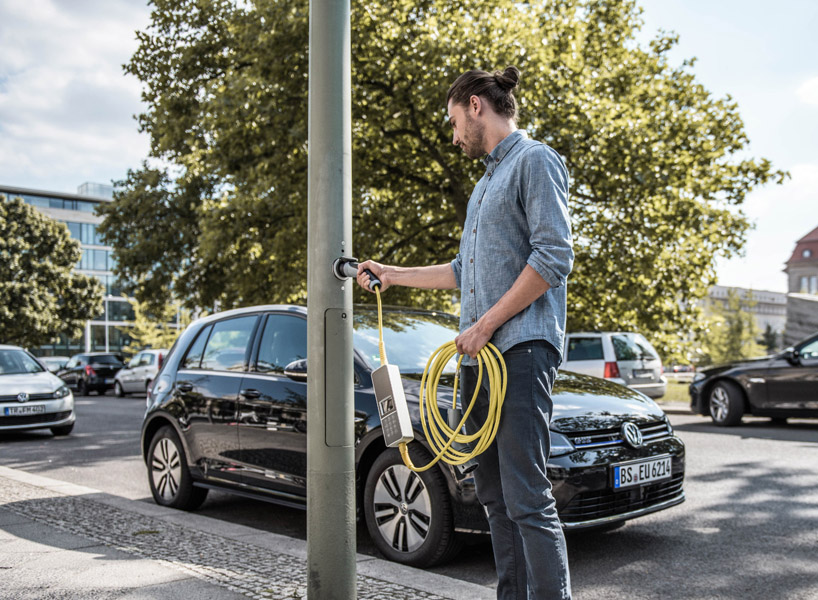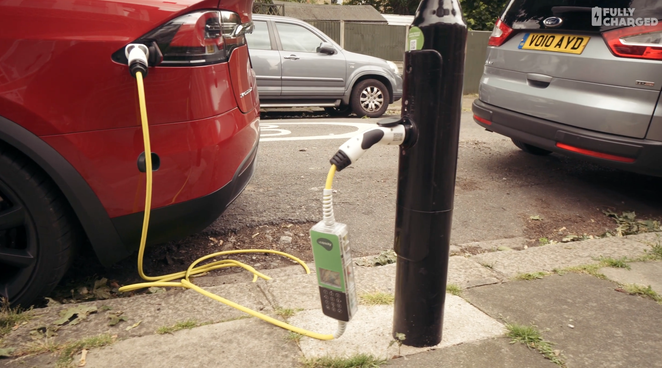
One of the big questions as we go towards electric car technology is where all those new vehicles are going to charge. The Independent reports that several London boroughs are converting some of their street light poles to also charge electric cars. Car owners buy a charging cord with a built-in meter that can be connected to the adapted street light pole. The meter records the cost of the charge.
Having this technology on the street means that residents who do not have off street parking are able to charge their vehicles, and also means that formal dedicated electric vehicle charging stations can be minimized. Some issues have been identified by planning staff such as “concerns of the cost of installation, charging points cluttering up streets, and implementing dedicated parking spaces.”
Locating the charging stations at light poles means that there is no need for costly infrastructure for charging stations, and minimal disruption on the existing streetscape. By making charging stations accessible to everyone, politicians hope that this will further incentivize the transition to electric vehicles and to cleaner air in London.














Author
Reblogged this on Sandy James Planner.
How does one pay, or does the city absorb the cost?
From the post:
“Car owners buy a charging cord with a built-in meter that can be connected to the adapted street light pole. The meter records the cost of the charge”
Probably paid like any other utility bill.
If it was me I would want to be able to physically lock that cable to the pole. That much copper is valuable in the scrap market.
The cable goes with the car, it doesn’t stay with the lamp post. https://www.designboom.com/technology/ubitricity-06-22-2017/
Some users may have concerns for security though, as there seems to be no way of preventing someone of stealing the expensive cable or simply removing it to charge their own car at your cost.
Read more: http://www.thisismoney.co.uk/money/cars/article-4607870/A-1-000-conversion-turn-lampposts-EV-chargers.html#ixzz4saHKdICN
Follow us: @MailOnline on Twitter | DailyMail on Facebook
“no need for expensive infrastructure”??
A street light uses maybe 100W of power.
An extravagantly lit block with say, 4 street lights on one side of the street might consume 400W
1 car is going to consume between 1400 watts and 10000 watts
If there are 22 parking spots, that’s 30,800 watts to 220,000 watts.
The infrastructure will need to be upgraded, and like all road infrastructure, it will be subsidized by the rest of us.
Presumably it starts slowly and users get charged per h or per kwh. I see a revenue opportunity here for cities, like parking meters.
The key issue is still acquisition price tag, lack of profitability for EV makers and range anxiety.
Most street light wiring was produced for high pressure sodium or high intensity discharge lights. 100w isn’t close to what a street lamp is using. That’s a bright incandescent bulb in your home from 5 years ago. A 10yr old street light was likely wired for at least 1000w of HPS/HID. With 4 street lights on a circuit which have now been replaced by 100w LED’s we’ve got 3600w available. And then factoring in the issues raised by Thomas, only a few folks will have them, and many who do will be parking inside as EV’s are being purchased by the new car market which is more likely to have access to private parking. Therefore, while not the only solution required, it shouldn’t be discounted.
A quick search shows that HPS is only about half as efficient as LED and many use only 150W. LED is superior in colour and perhaps in longevity.
Big difference between here and there: their lamps sun on 240v ours are 120v. That makes a huge difference in battery charging time.
Twice the voltage is four times the power, given the same current.
This will obviously not cover all the cars. Only a tiny number that park on the street will be close to street light poles that are often 30 m apart on one side, or staggered from one side to another.
I’m not that keen on this idea because it defeats the notion of fair road pricing where you are charged for the distance you drive, unless a levy is applied to the base power through the special meter. This is not a privately-owned energy source and distribution network like oil companies and their gas stations. The power and the lighting network are underpinned by the taxpayer, which tends to increase car dependency when added to the cost of subsidizing the existing massive road system.